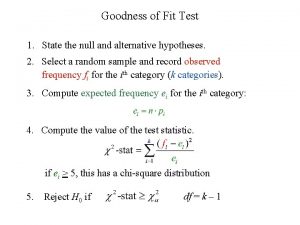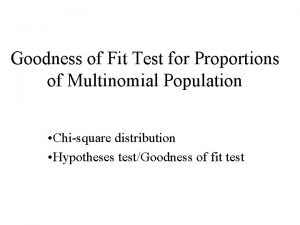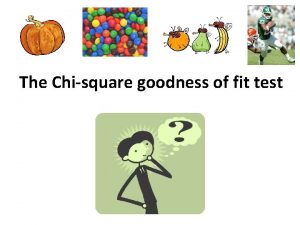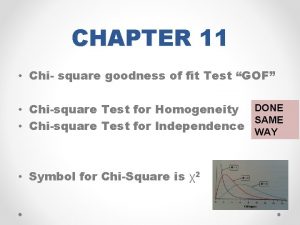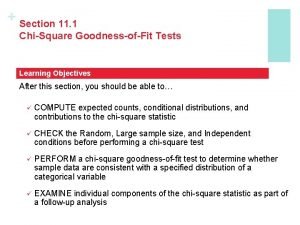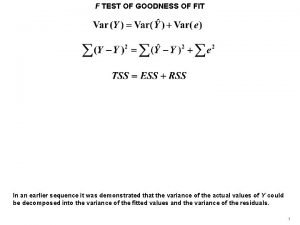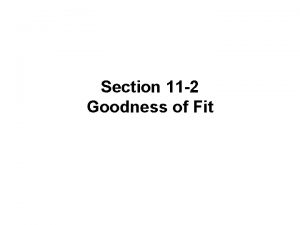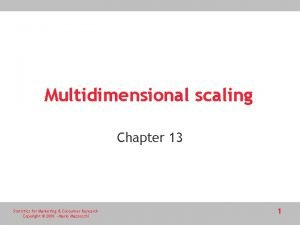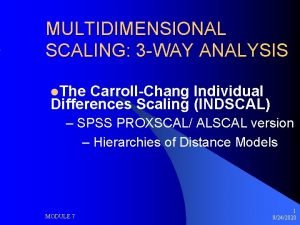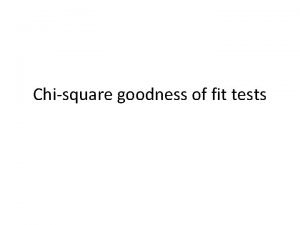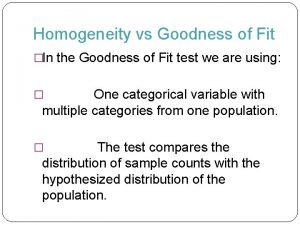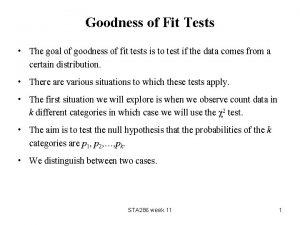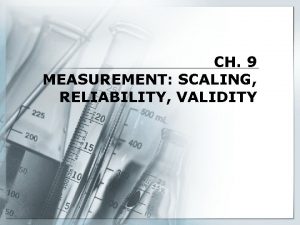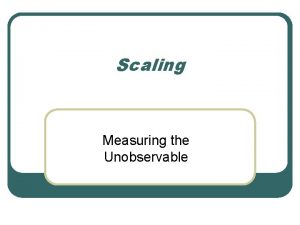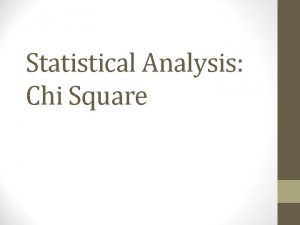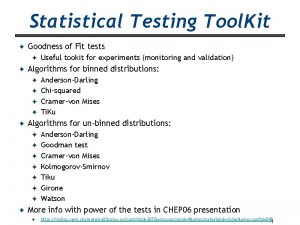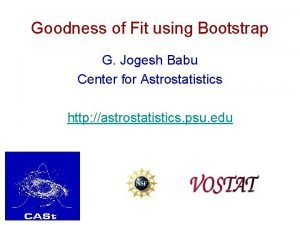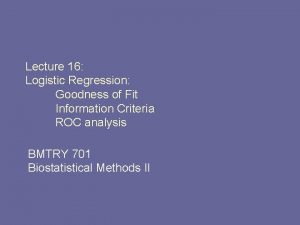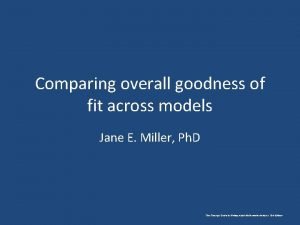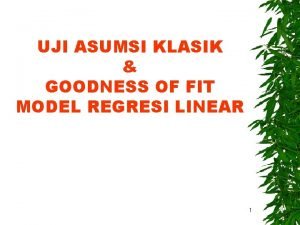Multidimensional Scaling Agenda Multidimensional Scaling Goodness of fit



























![Maximum Likelihood =[0] Y 1 Y 2 Y 3 0. 094 x 0. 2661 Maximum Likelihood =[0] Y 1 Y 2 Y 3 0. 094 x 0. 2661](https://slidetodoc.com/presentation_image_h2/f4a67d452c500696416a4aecfa853a5b/image-28.jpg)

- Slides: 29

Multidimensional Scaling

Agenda • Multidimensional Scaling • Goodness of fit measures • Nosofsky, 1986

Proximities p. Amherst, Hadley Amherst Belchertown Hadley Leverett Pelham Shutesbury Sunderland Belchertown 0 Hadley Leverett Pelham Shutesbury Sunderland 9. 94 4. 32 7. 29 6. 81 9. 94 7. 81 0 14. 06 14. 94 8. 25 13. 96 17. 66 0 11. 02 10. 93 14. 49 9. 5 0 12. 57 7. 45 5. 18 0 5. 71 16. 16 0 11. 04 0

Configuration (in 2 -D) xi

Configuration (in 1 -D)

Formal MDS Definition • f: pij dij(X) • MDS is a mapping from proximities to corresponding distances in MDS space. • After a transformation f, the proximities are equal to distances in X. Amherst Belcherto wn Hadley Leverett Pelham Shutesbu ry Sunderla nd 0 Belcherto wn Hadley Leverett Pelham Shutesbu ry Sunderla nd 9. 94 4. 32 7. 29 6. 81 9. 94 7. 81 0 14. 06 14. 94 8. 25 13. 96 17. 66 0 11. 02 10. 93 14. 49 9. 5 0 12. 57 7. 45 5. 18 0 5. 71 16. 16 0 11. 04 0

Distances, dij d. Amherst, Hadley(X)

Distances, dij

Distances, dij d. Amherst, Hadley(X)=4. 32

Proximities and Distances Proximities Amherst Belchertown 0 Belchertown Hadley Leverett Pelham Shutesbury Sunderland 9. 94 4. 32 7. 29 6. 81 9. 94 7. 81 0 14. 06 14. 94 8. 25 13. 96 17. 66 0 11. 02 10. 93 14. 49 9. 5 0 12. 57 7. 45 5. 18 0 5. 71 16. 16 0 11. 04 Hadley Leverett Pelham Shutesbury Sunderland 0 Distances Amherst Belchertown Hadley Leverett Pelham Shutesbury Sunderland Belchertown 0 Hadley Leverett Pelham Shutesbury Sunderland 10. 0577 6. 3325 7. 4738 7. 9313 7. 8319 7. 8328 0 12. 0455 16. 8332 6. 7959 12. 7215 17. 6600 0 12. 0350 13. 1492 14. 1632 8. 1892 0 12. 2097 7. 3591 6. 6429 0 6. 3360 15. 4250 0 12. 7366 0

The Role of f • f relates the proximities to the distances. • f(pij)=dij(X)

The Role of f • f can be linear, exponential, etc. • In psychological data, f is usually assumed any monotonic function. – That is, if pij<pkl then dij(X) dkl(X). – Most psychological data is on an ordinal scale, e. g. , rating scales.

Looking at Ordinal Relations Proximities Amherst Belchertown 0 Belchertown Hadley Leverett Pelham Shutesbury Sunderland 9. 94 4. 32 7. 29 6. 81 9. 94 7. 81 0 14. 06 14. 94 8. 25 13. 96 17. 66 0 11. 02 10. 93 14. 49 9. 5 0 12. 57 7. 45 5. 18 0 5. 71 16. 16 0 11. 04 Hadley Leverett Pelham Shutesbury Sunderland 0 Distances Amherst Belchertown Hadley Leverett Pelham Shutesbury Sunderland Belchertown 0 Hadley Leverett Pelham Shutesbury Sunderland 10. 0577 6. 3325 7. 4738 7. 9313 7. 8319 7. 8328 0 12. 0455 16. 8332 6. 7959 12. 7215 17. 6600 0 12. 0350 13. 1492 14. 1632 8. 1892 0 12. 2097 7. 3591 6. 6429 0 6. 3360 15. 4250 0 12. 7366 0

Stress • It is not always possible to perfectly satisfy this mapping. • Stress is a measure of how closely the model came. • Stress is essentially the scaled sum of squared error between f(pij) and dij(X)

Stress “Correct” Dimensionality Dimensions

Distance Invariant Transformations • Scaling (All X doubled in size (or flipped)) • Rotatation (X rotated 20 degrees left) • Translation (X moved 2 to the right)

Configuration (in 2 -D)

Rotated Configuration (in 2 -D)

Uses of MDS • Visually look for structure in data. • Discover the dimensions that underlie data. • Psychological model that explains similarity judgments in terms of distance in MDS space.

Simple Goodness of Fit Measures • Sum-of-squared error (SSE) • Chi-Square • Proportion of variance accounted for (PVAF) • R 2 • Maximum likelihood (ML)

Sum of Squared Error Data Prediction (Data-Prediction)2 7 5. 03 3. 88 8 6. 97 1. 06 1 2. 12 1. 25 8 8. 91 0. 83 6 6. 97 0. 94 SSE 7. 97

Chi-Square (Data Prediction)2/Predic tion Data Prediction (Data. Prediction)2 7 5 4 0. 80 8 7 1 0. 14 1 2 1 0. 50 8 9 1 0. 11 6 7 1 0. 14 Chi-Square 1. 70

Proportion of Variance Accounted for Data 7 8 1 8 6 Mean Prediction Mean Error 2 6 1 1 6 2 4 6 6 6 -5 2 0 SST 25 4 0 34 Model Prediction Error 2 5. 03 1. 97 3. 88 6. 97 1. 03 1. 06 2. 12 8. 91 6. 97 -1. 12 -0. 91 -0. 97 SSE (SST-SSE)/SST = (34 -7. 96)/34 =. 77 1. 25 0. 83 0. 94 7. 96

R 2 • R 2 is PVAF, but… Data 7 8 1 8 6 Mean Prediction Mean Error 2 6 1 1 6 2 4 6 6 6 -5 2 0 SST 25 4 0 34 Model Prediction Error 2 5. 9 1. 1 1. 21 10. 1 -2. 1 4. 41 4 5. 9 1 -3 2. 1 5 SSE (SST-SSE)/SST = (34 -44. 03)/34 = -0. 295 9 4. 41 25 44. 03

Maximum Likelihood • Assume we are sampling from a population with probability f(Y; ). • The Y is an observation and the are the model parameters. =[0] Y N(-1. 7; [ =0])=0. 094

Maximum Likelihood • With independent observations, Y 1…Yn, the joint probability of the sample observations is: =[0] Y 1 Y 2 Y 3 0. 094 x 0. 2661 x. 3605 =. 0090

Maximum Likelihood • Expressed as a function of the parameters, we have the likelihood function: • The goal is to maximize L with respect to the parameters, .
![Maximum Likelihood 0 Y 1 Y 2 Y 3 0 094 x 0 2661 Maximum Likelihood =[0] Y 1 Y 2 Y 3 0. 094 x 0. 2661](https://slidetodoc.com/presentation_image_h2/f4a67d452c500696416a4aecfa853a5b/image-28.jpg)
Maximum Likelihood =[0] Y 1 Y 2 Y 3 0. 094 x 0. 2661 x. 3605 =. 0090 =[-1. 0167] Y 1 Y 2 Y 3 0. 3159 x 0. 3962 x. 3398 =. 0425 (Assuming =1)

Maximum Likelihood • Preferred to other methods – Has very nice mathematical properties. – Easier to interpret. – We’ll see specifics in a few weeks. • Often harder (or impossible? ) to calculate than other methods. • Often presented as log likelihood, ln(ML). – Easier to compute (sums, not products). – Better numerical resolution. • Sometimes equivalent to other methods. – E. g. , same as SSE when calculating mean of a distribution.
 Next fit memory allocation
Next fit memory allocation First fit memory allocation
First fit memory allocation Goodness of fit
Goodness of fit Null
Null Multinomial goodness of fit
Multinomial goodness of fit Chi square test goodness of fit
Chi square test goodness of fit Chi-square test of homogeneity
Chi-square test of homogeneity Goodness of fit adalah
Goodness of fit adalah Casinos are required to verify that their games
Casinos are required to verify that their games F-test formula
F-test formula Goodness of fit test ti 83
Goodness of fit test ti 83 Chi square goodness of fit p value
Chi square goodness of fit p value Uji goodness of fit adalah
Uji goodness of fit adalah Multidimensional scaling marketing
Multidimensional scaling marketing Proxscal vs alscal
Proxscal vs alscal Multidimensional scaling - ppt
Multidimensional scaling - ppt Person-job fit and person-organization fit
Person-job fit and person-organization fit Maximum metal condition (mml) corresponds to the
Maximum metal condition (mml) corresponds to the Agenda sistemica y agenda institucional
Agenda sistemica y agenda institucional Mercy and goodness give me assurance
Mercy and goodness give me assurance How goodness pays
How goodness pays Criteria of goodness of a measurement scale
Criteria of goodness of a measurement scale Experiments in goodness
Experiments in goodness Holy spirit fill the atmosphere
Holy spirit fill the atmosphere Skala stapel
Skala stapel Quotes from elizabeth in the crucible
Quotes from elizabeth in the crucible Thou nature art my goddess
Thou nature art my goddess Ood goodness criteria
Ood goodness criteria Sing of the lords goodness
Sing of the lords goodness Lord byron writing style
Lord byron writing style



